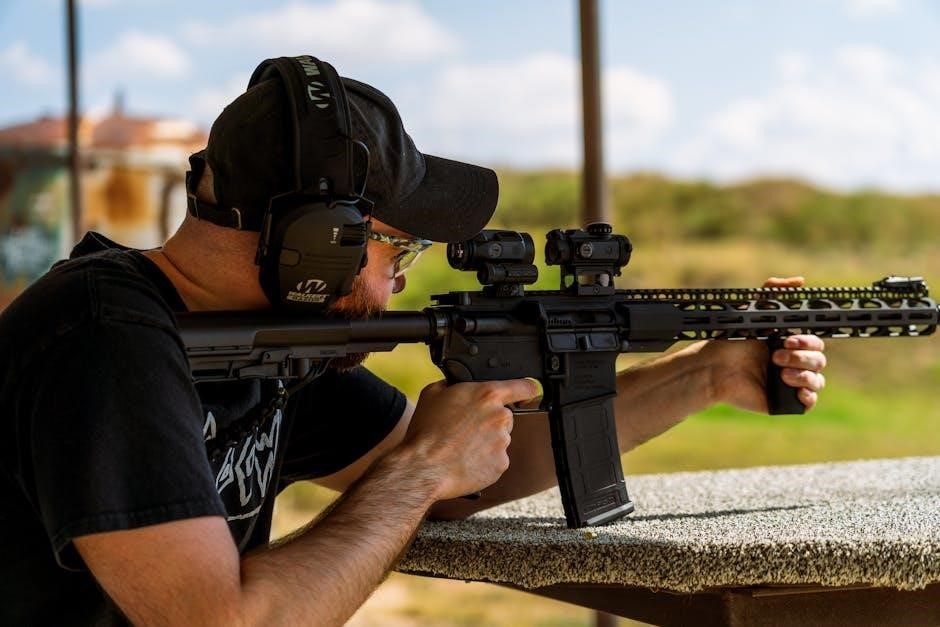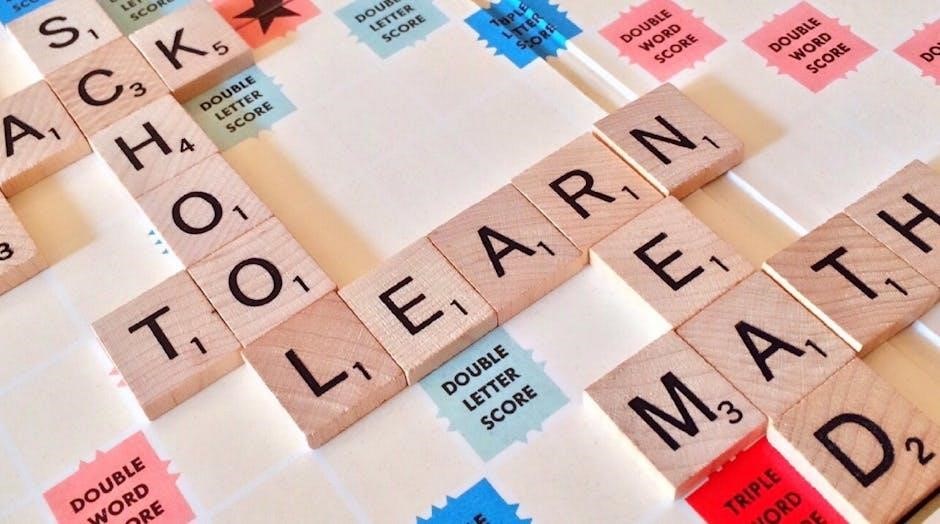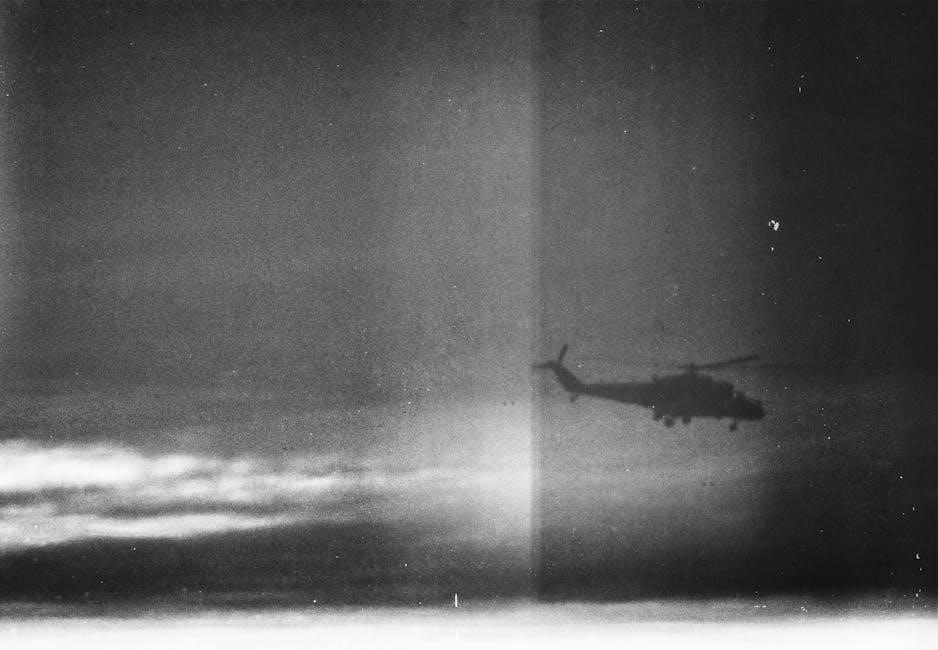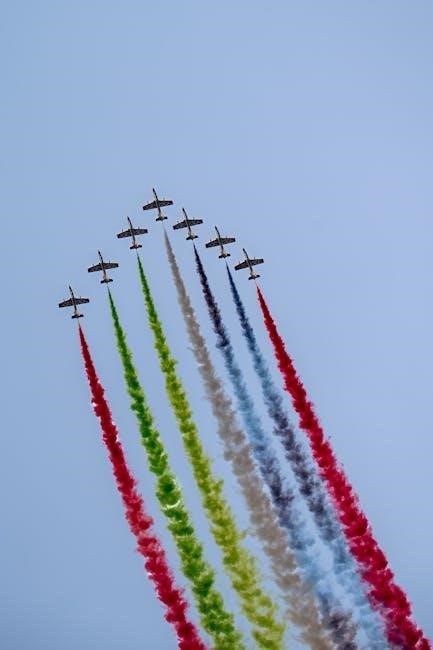The military alphabet, also known as the NATO Phonetic Alphabet, is a standardized system for clear communication. It replaces confusing letters with unique code words, ensuring accuracy in various fields. A military alphabet PDF provides a quick reference guide, including pronunciation and examples, making it essential for training and daily use.
What is the Military Alphabet?
The military alphabet, also known as the NATO Phonetic Alphabet, is a standardized communication system designed to clearly convey letters and numbers. It replaces confusing sounds with distinct code words, ensuring clarity in voice communications. This system is widely used in military, aviation, and telecom industries to avoid misunderstandings. Each letter is assigned a unique word, such as “Alfa” for A and “Bravo” for B. The military alphabet is essential for precise communication, especially in noisy or high-stress environments. PDF templates of the military alphabet are available for download, providing a handy reference guide for learning and using the system effectively in various professional settings.

Importance in Communication

The military alphabet is crucial for clear and accurate communication, especially in high-stakes environments like aviation, military operations, and emergency services. By using unique code words, it eliminates confusion caused by similar-sounding letters or poor transmission quality. For example, “Alfa” and “Bravo” are distinct and easily recognizable, reducing errors in critical situations. This system is indispensable in radio communications, where clarity is paramount. Its universal adoption ensures that professionals across industries can communicate effectively, regardless of language or accent. The availability of military alphabet PDF templates makes it accessible for training and reference, further enhancing its role in maintaining precise and reliable communication worldwide.

History and Development
The military alphabet was formalized in the mid-20th century, evolving from earlier phonetic systems to improve clarity in radio communications. It was standardized by NATO, ensuring universal adoption. The development included refining code words to minimize confusion, with periodic updates to reflect modern communication needs. This structured system became essential for global military and aviation operations. The availability of military alphabet PDF guides has further facilitated its dissemination and training, solidifying its role in modern communication protocols.
Origins
The military alphabet, also known as the NATO phonetic alphabet, traces its origins to the early 20th century. Initially developed to address communication challenges in military and aviation settings, it evolved to ensure clarity in radio transmissions. The system was first standardized in the 1920s by the International Telecommunication Union (ITU) and later refined by NATO in the 1950s. This phonetic system assigns unique code words to letters and numbers, reducing misunderstandings. Its creation was driven by the need for precise communication in high-stakes environments. Today, resources like the military alphabet PDF provide easy access to this essential tool for training and reference.
Evolution Over Time
The military alphabet has undergone significant changes since its inception. The modern version, standardized by NATO in 1959, replaced earlier systems that were less effective. The phonetic alphabet was refined to eliminate ambiguities, with words chosen for clarity and distinctiveness. For example, “Baker” replaced “Bacon” to reduce confusion. Over time, its adoption expanded beyond military use, becoming a standard tool in aviation, maritime, and emergency services. The development of resources like the military alphabet PDF has made it more accessible, ensuring its continued relevance. This evolution reflects its adaptability to meet the needs of clear and precise communication across various industries.
Key Features
The military alphabet uses unique spellings and pronunciation guidelines to ensure clarity. Each letter is assigned a distinct code word, like “Alpha” for A and “Bravo” for B, minimizing confusion in communication.
Unique Spellings
The military alphabet employs distinct code words for each letter, ensuring clear communication. For example, “A” becomes “Alpha,” “B” is “Bravo,” and “C” is “Charlie.” These unique spellings eliminate confusion between similar-sounding letters, such as “Lima” for “L” and “Sierra” for “S.” The system avoids using words that sound alike, making it highly effective in noisy or high-stress environments. This standardized approach ensures consistency across languages and dialects, fostering precise understanding globally. The unique spellings are a cornerstone of the military alphabet, enabling reliable transmission of critical information. This feature is particularly vital in military, aviation, and emergency response contexts where clarity is paramount. The spellings are widely recognized and used universally.
Pronunciation Guidelines
The military alphabet includes specific pronunciation guidelines to ensure clarity. Each code word is spoken with emphasis on the first syllable, such as “Bravo” (BRAH-voh) and “Charlie” (CHAR-lee). This standardized approach minimizes errors in communication. For example, “Delta” is pronounced “DELL-tah,” while “Foxtrot” is “FOKS-trot.” The stress on the first syllable helps distinguish similar-sounding words. Proper pronunciation is critical, especially in high-stress environments. Learners are encouraged to practice with audio resources to master the correct intonation. Consistent pronunciation ensures messages are understood without ambiguity, making it a vital component of the system. These guidelines are universally applied across languages and dialects, ensuring global compatibility and effectiveness.

Usage in Various Fields
The military alphabet is widely used in military, aviation, and telecommunications to ensure clear communication. It is also applied in emergency services and nautical operations for precision and clarity.
Military Applications
The military alphabet is a cornerstone of clear communication in armed forces worldwide. It is used to avoid confusion during radio transmissions, where standard letter sounds can be easily misheard. For example, “Bravo” and “Charlie” are distinct, reducing errors in critical missions. Soldiers rely on this system for coordinating operations, delivering orders, and reporting positions. Its standardized nature ensures consistency across different units and branches. Additionally, it is integral to training exercises, tactical planning, and identification of personnel or equipment. The military alphabet’s precision is vital in high-stakes environments, making it an indispensable tool for modern armed forces. Its adoption has been universal across military organizations globally.
Aviation and Telecom
The military alphabet is widely used in aviation and telecommunications to ensure clear communication. In aviation, pilots and air traffic controllers use it to avoid confusion during radio transmissions, where sounds like “S” and “F” can be easily mixed up. For instance, “Sierra” (S) and “Foxtrot” (F) are distinct and prevent errors. Similarly, in telecom, it is used by radio operators to relay messages accurately, especially in noisy environments. This system is also adopted by emergency services and maritime communications. Its universal adoption ensures consistency and clarity, making it a critical tool in industries where precise communication is paramount. This has saved countless lives and prevented accidents.
Learning the Alphabet
Mastery of the military alphabet requires consistent practice. Use flashcards, audio tools, and group study for better retention. Apply real-world exercises to reinforce learning effectively.
Pronunciation Guide
Mastery of the military alphabet begins with precise pronunciation. Each letter is assigned a unique word with distinct phonetics to ensure clarity in communication. For example, “Bravo” is pronounced “BRAH-voh,” while “Charlie” is “CHAR-lee.” Pay attention to syllable stress and rhythm, as incorrect pronunciation can lead to misunderstandings. Practice articulating each word clearly, emphasizing the stressed syllable. Regular listening to audio resources or native speakers can refine your delivery. Consistent practice ensures that your communication remains accurate and effective in high-stakes environments. Focus on maintaining a steady pace and avoiding mumbling to guarantee clear transmission of each letter.
Practice Exercises
Mastering the military alphabet requires consistent practice. Start with flashcard drills, associating each letter with its corresponding word. Write exercises where you spell words using the alphabet can enhance retention. Audio drills, where you listen and repeat, improve pronunciation and recognition. Timed tests help build speed and accuracy under pressure. Pair up with a partner for interactive sessions, taking turns to spell and identify letters. Use printable worksheets or online tools to track progress. Regular practice strengthens muscle memory, ensuring quick and accurate communication. Consistency is key to becoming proficient in the military alphabet, making it an invaluable skill in both professional and casual settings.

Downloadable Resources
Military alphabet PDFs offer convenient learning tools, including charts, quick reference guides, and printable posters. These resources are ideal for training and everyday use, ensuring easy access to the phonetic alphabet system.

PDF Templates

Military alphabet PDF templates are essential for mastering the phonetic alphabet system. These templates often include charts, quick reference guides, and flashcards to aid in learning and practice. Designed for clarity and organization, they provide a structured approach to understanding each letter’s corresponding code word. Many templates are customizable, allowing users to tailor them to specific needs, such as highlighting frequently used codes or adding notes. With high-resolution designs, these PDFs are ideal for printing or digital use, ensuring readability in various settings. Whether for military training, aviation, or personal study, military alphabet PDF templates are a versatile and practical resource.
Printable Posters
Printable posters of the military alphabet are a visually engaging tool for learning and reference. Designed for clarity, these posters typically feature large, easy-to-read text and a clean layout. They often include the 26 code words alongside their corresponding letters, making them ideal for classrooms, offices, or training environments. Many posters are available in multiple sizes, such as A4 or letter format, and can be printed in high resolution for crisp display. Some designs incorporate color-coded sections or quick-reference boxes to enhance usability. Whether for educational purposes or professional use, these posters serve as a practical and accessible learning aid.
Interactive Tools
Interactive tools for learning the military alphabet offer dynamic and engaging ways to master the code. Online converters allow users to input text and receive instant phonetic translations, perfect for quick reference. Flashcard apps and games provide hands-on practice, testing knowledge through quizzes and challenges. Some tools include audio features, enabling users to hear correct pronunciations. Interactive charts and simulators let learners explore letter-sound associations in real time. These tools are especially useful for beginners, as they make learning fun and accessible. Regular use of these resources can significantly improve proficiency in using the military alphabet for communication.
Common Misconceptions

Many believe the military alphabet is only for military use, but it’s widely used in aviation and telecom for clarity. Others think it’s overly complex or outdated, but its simplicity ensures effective communication. A common misconception is that it’s just about unique spellings, when in fact, precise pronunciation is equally crucial. Some assume it’s easy to learn without practice, but mastery requires consistent effort. Understanding these misconceptions helps in appreciating the system’s universal value and practicality in diverse professional settings.
Alpha vs. Alfa
A common confusion arises between “Alpha” and “Alfa” in the military alphabet. While both refer to the letter “A,” the difference lies in their phonetic origins. “Alpha” is the standard term used in the NATO phonetic alphabet, designed to avoid confusion with “Alfa,” which is the Spanish word for “alpha.” This distinction ensures clarity in international communication, particularly in multilingual environments. Many people mistakenly believe they are interchangeable, but “Alpha” is the correct and universally accepted term. This subtle difference highlights the system’s attention to detail in maintaining unambiguous communication across languages and regions.
Juliett vs. Juliet
In the military alphabet, “Juliett” is the official term for the letter “J,” while “Juliet” is a common variant. The double “t” in “Juliett” ensures clarity, especially in radio communication, where “Juliet” might be confused with other words. This distinction is crucial for avoiding errors in high-stakes environments. The use of “Juliett” aligns with the NATO phonetic alphabet’s goal of minimizing ambiguity. While “Juliet” is widely recognized, “Juliett” is the standardized version used in official contexts. This subtle difference reflects the system’s emphasis on precision and reliability in global communication systems.

Tools and Resources
Explore military alphabet PDF guides, cheat sheets, and code converters. Utilize Python converters for seamless translation and integration into various systems, ensuring accuracy and efficiency in communication.
Python Converter
A Python converter is a versatile tool designed to translate text into the military alphabet. It automates the process, ensuring accuracy and efficiency. Users can input phrases, and the converter outputs the corresponding military alphabet codes. This tool is particularly useful for individuals needing precise communication in fields like aviation or telecommunications. Many Python libraries and scripts are available online, offering customizable solutions. Developers can integrate these converters into larger systems, enhancing functionality. Whether for training or operational use, Python-based military alphabet converters provide reliable and adaptable solutions. They are widely accessible and support various formats, including PDF outputs for easy reference.
Cultural Impact
The military alphabet has influenced popular culture, appearing in films, TV shows, and video games. Its unique codes add authenticity to military and tactical portrayals, intriguing audiences worldwide.
Pop Culture References
The military alphabet has become a staple in pop culture, frequently featured in movies, TV shows, and video games. Films like Top Gun and series like NCIS use it to add authenticity to military scenes. Video games such as Call of Duty incorporate it for realistic communication. Its distinctive codes, like “Bravo” and “Charlie,” are instantly recognizable, evoking a sense of urgency and professionalism. This cultural presence highlights its enduring relevance beyond military circles, making it a familiar and intriguing element for global audiences. Its popularity underscores its effectiveness in clear communication, even in fictional settings.
The military alphabet, also known as NATO phonetic alphabet, is a vital tool for clear communication in various fields. Its structured design ensures precision, reducing errors in high-stakes environments. Widely used in military, aviation, and telecommunications, it has proven indispensable for effective coordination. Beyond professional settings, its cultural impact is evident in media and popular culture. Learning and using this alphabet enhances clarity and efficiency, making it a valuable skill for anyone seeking to improve communication. Whether for professional purposes or personal knowledge, the military alphabet remains a timeless and universal system, ensuring understanding across languages and backgrounds.



